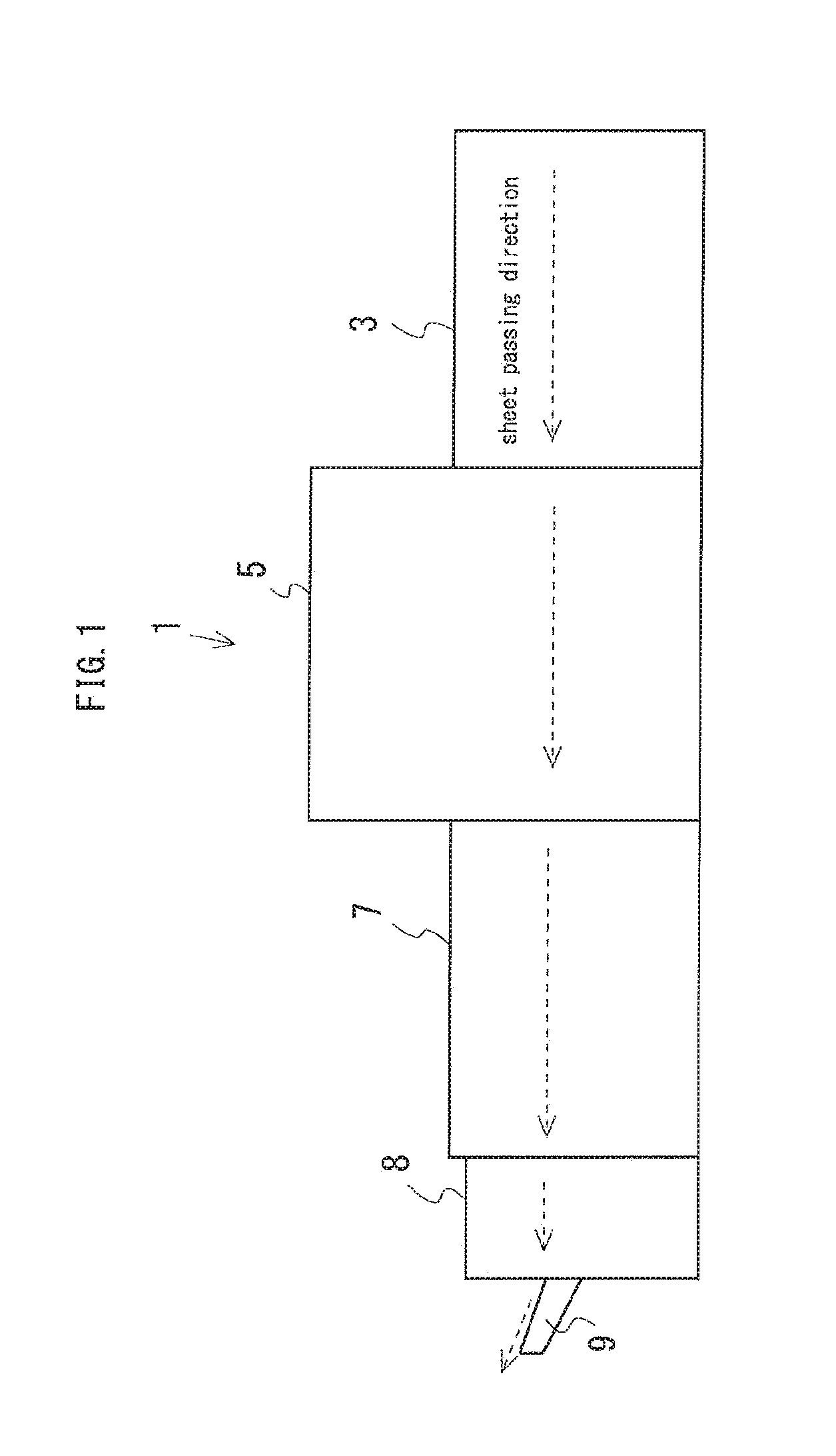Image reading apparatus and image forming system
a reading apparatus and image technology, applied in the direction of electrographic process apparatus, instruments, optics, etc., can solve the problems of inability of scanners to correctly detect the color tone of images printed on the sheet, unstable luminance of light emitted from led elements, and imbalanced surface temperature of sheets
- Summary
- Abstract
- Description
- Claims
- Application Information
AI Technical Summary
Benefits of technology
Problems solved by technology
Method used
Image
Examples
embodiment 1
[0044]FIG. 1 is a schematic diagram for showing the overall configuration of an image forming system 1 in accordance with an embodiment 1. As illustrated in FIG. 1, the image forming system 1 includes a paper feed apparatus 3, an image forming apparatus 5, an image reading apparatus 7 and a discharge unit 8. The paper feed apparatus 3 is responsible for feeding a sheet P to the image forming apparatus 5. The image forming apparatus 5 is responsible for forming an image on a sheet P fed by the paper feed apparatus 3, i.e., printing the image on the sheet P. The image reading apparatus 7 is responsible for reading a sheet P on which an image is printed by the image forming apparatus 5, and performing various types of processing. The discharge unit 8 is provided with a catch tray 9, and discharges a sheet P, which is conveyed from the image reading apparatus 7, to the catch tray 9.
[0045]Next, the image forming apparatus 5 will be specifically explained. FIG. 2 is a diagram for showing ...
embodiment 2
[0169]In this embodiment 2, similar elements are given similar references as in the embodiment 1, and therefore no redundant description is repeated. As described below, this embodiment 2 differs from the embodiment 1 in that ducts 153 are arranged to blow out air from fans 151 in a different direction.
[0170]FIG. 15 is a view for schematically showing the situation in which a cooling air is prevented from blowing on a sheet P by ducts 153a and 153b of the embodiment 2. Namely, as illustrated in FIG. 15, the ducts 153a and 153b are installed in order to lead air to the heat sinks 143. The fans 151 are arranged in order to produce an air flow along the ducts 153a and 153b respectively. The duct 153a is arranged in order to send air from the fans 151 to point light sources 131a and 131b located in this duct without leaking air to the outside. The duct 153b is arranged in order to send air from the fans 151 to point light sources 131c and 131d located in this duct without leaking air to...
embodiment 3
[0175]In this embodiment 3, similar elements are given similar references as in the embodiments 1 and 2, and therefore no redundant description is repeated. As described below, this embodiment 3 differs from the embodiments 1 and 2 in that blocking members 155 are provided.
[0176]FIG. 16 is a view for schematically showing the situation in which a cooling air is prevented from blowing on a sheet P by the blocking members 155 of the embodiment 3. Namely, as illustrated in FIG. 16, the blocking member 155 is provided between the fan 151 and the heat sink 143 to cover the periphery of the heat sink 143 and prevent heat from being transmitted to a sheet P. The blocking member 155 blocks air propelled from the fan 151 before the air reaches a sheet P.
[0177]As described above, in the image reading apparatus 7 provided with the blocking member 155 between the fan 151 and the heat sink 143, the air propelled from the fan 151 does not blow on a sheet P. The temperature distribution of a sheet...
PUM
 Login to View More
Login to View More Abstract
Description
Claims
Application Information
 Login to View More
Login to View More - R&D
- Intellectual Property
- Life Sciences
- Materials
- Tech Scout
- Unparalleled Data Quality
- Higher Quality Content
- 60% Fewer Hallucinations
Browse by: Latest US Patents, China's latest patents, Technical Efficacy Thesaurus, Application Domain, Technology Topic, Popular Technical Reports.
© 2025 PatSnap. All rights reserved.Legal|Privacy policy|Modern Slavery Act Transparency Statement|Sitemap|About US| Contact US: help@patsnap.com



